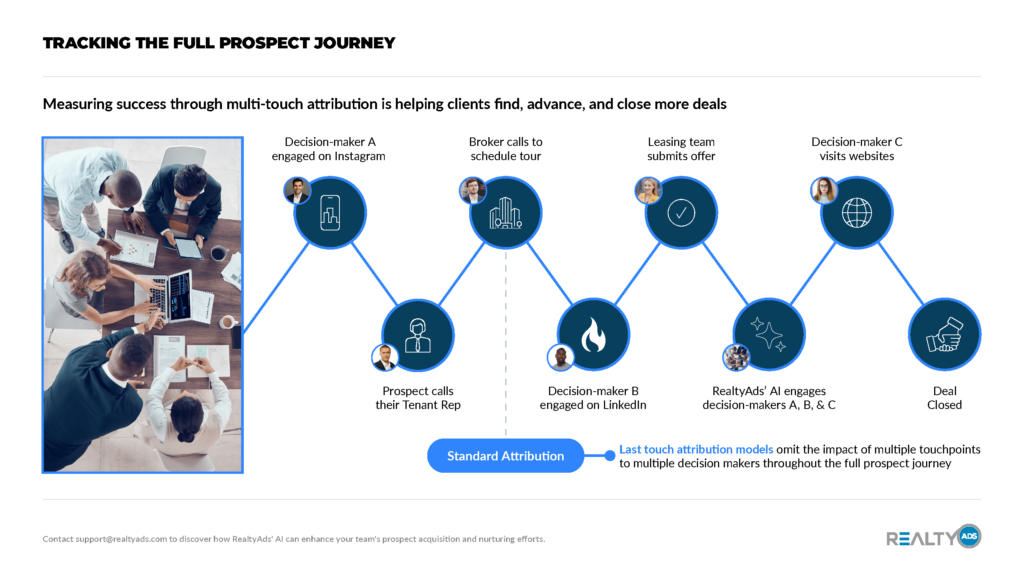In commercial real estate (CRE), the focus of marketing success is often measured by the final action—a completed lead form or a call to a broker. This “last-touch” attribution model, while simple, overlooks the complex journey prospects take before reaching these endpoints. By focusing solely on the last measurable touchpoint, CRE marketing teams risk misallocating budgets, undervaluing critical engagement strategies, and missing opportunities to nurture prospects effectively. Drawing from industry data and RealtyAds’ insight, this blog explores why a broader view of the prospect journey is essential for driving inquiries, leases, and long-term property health.
The Problem With Last-Touch Attribution

The document below, Tracking the Full Prospect Journey, outlines a decision-maker’s path in CRE: seeing a RealtyAds ad, calling a broker, scheduling a tour, and engaging with follow-ups and nurturing strategies. Yet, traditional metrics often credit only the final action—like a form submission or a broker call—ignoring the multiple touchpoints that build awareness and conviction. This approach is flawed for several reasons:
- Assumes a Single Decision Maker: In CRE, decisions are rarely made by one person. A committee of 5+ stakeholders—such as the CFO, CEO, Real Estate Directors, etc.—collectively influences the transaction. A single lead form from one committee member represents only a fraction of the decision-making process. Touchpoints like digital ads and website visits shape the committee’s collective perception but are often invisible in last-touch models.
- Misguides Budget Allocation: By prioritizing channels that generate final actions, teams may underfund strategies like sustained digital strategies across social media that drive both initial interest and nurture prospects over their entire lifecycle.
- Ignores the Complexity of CRE Transactions: Unlike consumer purchases, CRE deals involve long sales cycles, multiple stakeholders, and factors like property amenities, location, and pricing. Giving 100% of the credit to the last touch fails to capture the full scope of influences; it only shows an impact at a brief moment in time over CRE’s long sales cycle.
RealtyAds’ analysis of over 60,000 transactions reveals that clients with a sustained digital strategy see a 30% increase in tours and an 18% increase in closed deals. What’s more, 84% of transactions die after the last touch attribution (inquiry or tour, depending on the client). This underscores the value of consistent engagement across the prospect journey, far beyond the final touch.
The Power of Sustained Touchpoints

Research supports the idea that multiple touchpoints are critical for building prospect conviction and accelerating deals. According to Salesforce, generating a viable sales lead takes 6 to 8 marketing touchpoints. McKinsey has also noted that “consistent brand interaction across multiple channels” increases buyer confidence and shortens deal cycles. In CRE, where decisions involve high stakes and long timelines, sustained engagement is even more crucial. Here’s why:
- Building Conviction: Each touchpoint—whether a pre-tour ad highlighting a building’s fitness center or a post-tour ad emphasizing proximity to transit—reinforces the property’s value proposition. RealtyAds’ AI tracks decision-makers’ repeated website visits, showing how ongoing exposure strengthens interest.
- Speeding Up Decisions: A 2023 MarketingProfs report noted that nurtured leads progress through the sales funnel 20% faster than non-nurtured ones. In CRE, follow-up efforts like RealtyAds’ Prospect Boosting keep prospects engaged, reducing the time from inquiry to tour and tour to lease.
- Expanding Reach: Digital strategies, including targeted social media ads, reach decision-makers actively searching for space. RealtyAds’ evergreen ads ensure consistent visibility, fostering familiarity even before prospects take action, and often engage the whole decision-making committee.
RealtyAds’ article, Why Traditional Digital Metrics Don’t Work for Commercial Real Estate—and What Does, details how legacy metrics like click-through rates fail to capture these broader dynamics. Instead, metrics like tour volume, engagement of local brokers, and decision-maker engagement after the tour better reflect marketing’s impact on the transaction process.
A Holistic Approach To Measuring Attribution

To optimize CRE marketing, teams must adopt a multi-touch attribution model that accounts for the full prospect journey. Here’s how:
- Track All Touchpoints: Use tools like RealtyAds’ AI to monitor broker engagement on social, website visits by prospects, and decision-maker interactions. This reveals which channels are successfully engaging your customers, not just conversions.
- Invest in Sustained Engagement: Allocate budgets to both pre- and post-inquiry nurturing. RealtyAds’ data from more than 60,000 transactions shows these efforts directly correlate with higher tour and close rates.
- Use CRE’s Long Sales Cycle to Your Advantage: Emphasize unique features—amenities, views, or location—in every touchpoint to differentiate your offering. This builds a compelling case over time; something most CRE deals have plenty of.
Conclusion
Focusing only on the last touch—whether a broker call or a form submission—misses the bigger picture of what drives CRE transactions. By valuing the full prospect journey, from initial ad exposure to post-tour nurturing, marketing teams can better allocate resources, enhance prospect conviction, and close more deals.
RealtyAds’ data and industry research confirm that sustained touchpoints are key to unlocking a 30% increase in tours and an 18% increase in leases. To learn more about how RealtyAds can help you track and optimize the entire prospect journey, visit realtyads.com.
Resources:
- Salesforce: “It takes 6 to 8 marketing touchpoints to generate a viable sales lead.”
- McKinsey: “Consistent brand interaction across multiple channels increases buyer confidence and shortens deal cycles.”
- MarketingProfs: “Nurtured leads progress through the sales funnel 20% faster than non-nurtured ones.”

